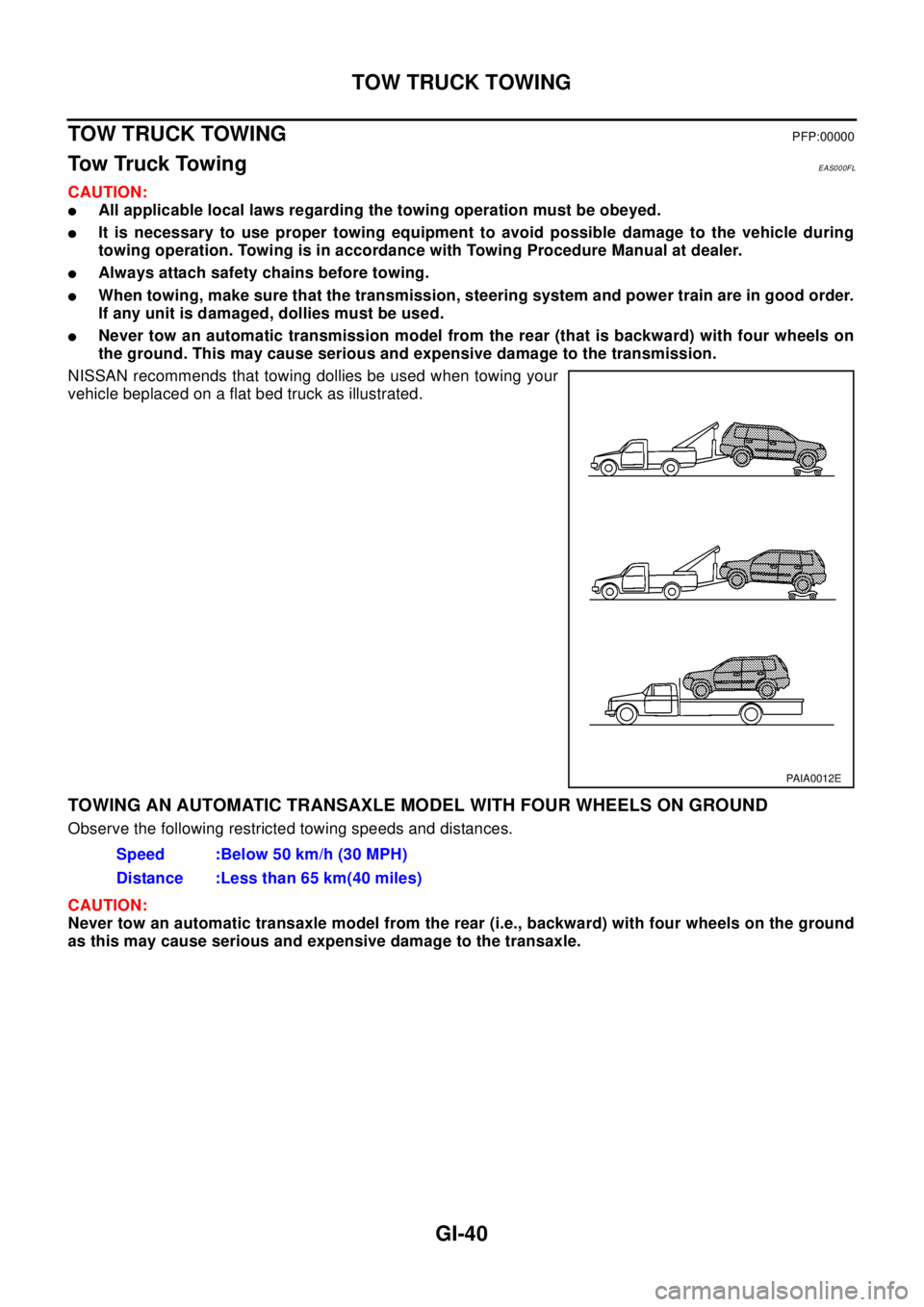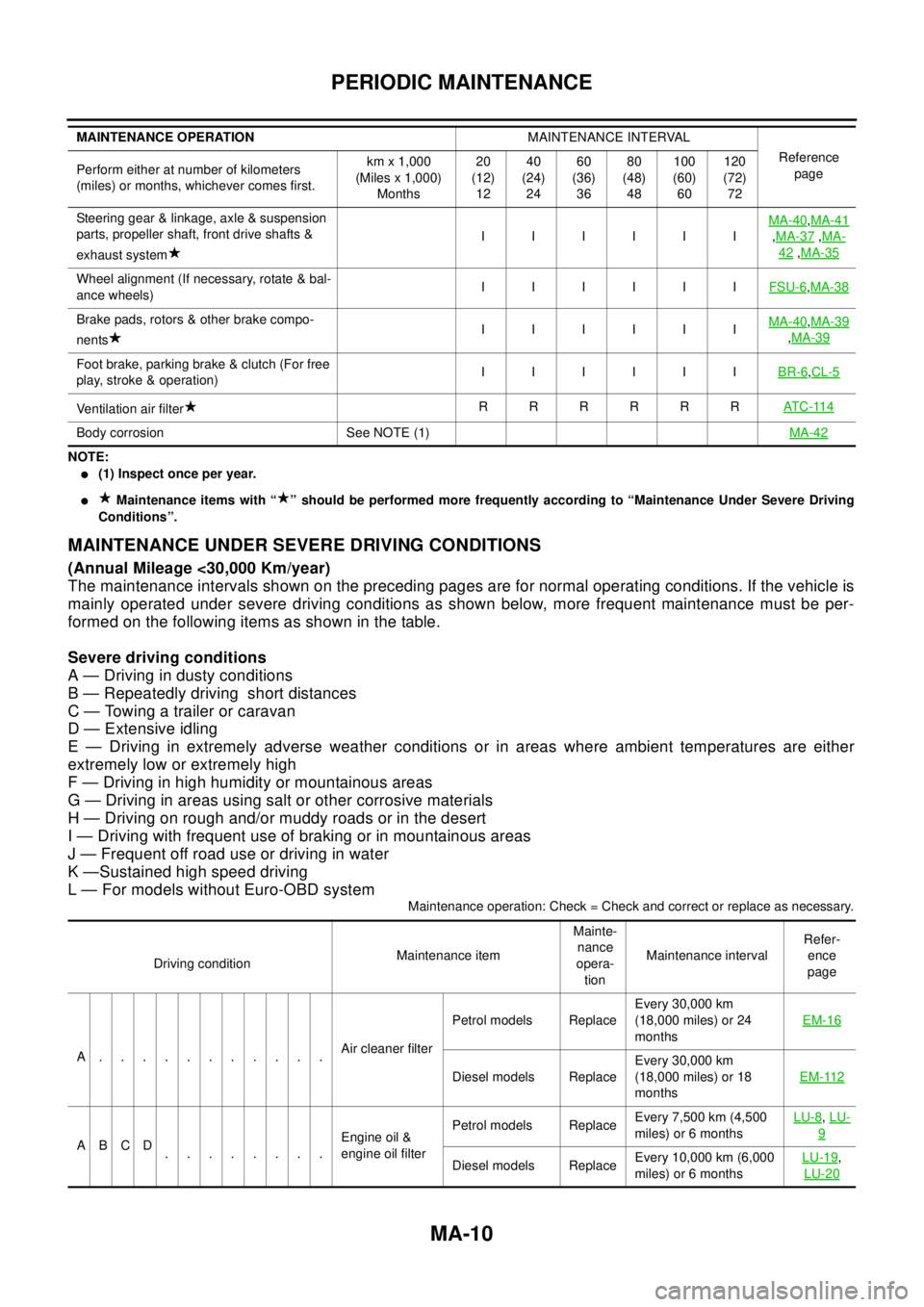2003 NISSAN X-TRAIL towing
[x] Cancel search: towingPage 2254 of 3066

GI-1
GENERAL INFORMATION
A GENERAL INFORMATION
CONTENTS
C
D
E
F
G
H
I
J
K
L
MB
GI
SECTION
GENERAL INFORMATION
PRECAUTIONS .......................................................... 3
Description ............................................................... 3
Precautions for Supplemental Restraint System
(SRS) “AIR BAG” and “SEAT BELT PRE-TEN-
SIONER” .................................................................. 3
Precautions for NATS (NISSAN ANTI-THEFT SYS-
TEM) ........................................................................ 3
General Precautions ................................................ 4
Precautions for All Mode 4´4 System .................... 5
Precautions for Three Way Catalyst ......................... 5
Precautions for Fuel ................................................. 5
Precautions for Multiport Fuel Injection System or
Engine Control System ............................................ 6
Precautions for Turbocharger (If Equipped) ............. 6
Precautions for Hoses .............................................. 6
HOSE REMOVAL AND INSTALLATION ............... 6
HOSE CLAMPING ................................................ 7
Precautions for Engine Oils ...................................... 7
HEALTH PROTECTION PRECAUTIONS ............. 7
ENVIRONMENTAL PROTECTION PRECAU-
TIONS ................................................................... 7
Precautions for Air Conditioning ............................... 8
HOW TO USE THIS MANUAL ................................... 9
Description ............................................................... 9
Terms ....................................................................... 9
Units ......................................................................... 9
Contents ................................................................... 9
Components ............................................................. 9
SYMBOLS ........................................................... 10
How to Follow Trouble Diagnoses .......................... 10
DESCRIPTION .................................................... 10
HOW TO FOLLOW TEST GROUPS IN TROU-
BLE DIAGNOSES ................................................11
HARNESS WIRE COLOR AND CONNECTOR
NUMBER INDICATION ....................................... 12
KEY TO SYMBOLS SIGNIFYING MEASURE-
MENTS OR PROCEDURES ............................... 13
How to Read Wiring Diagrams ............................... 14
CONNECTOR SYMBOLS ................................... 14
SAMPLE/WIRING DIAGRAM - EXAMPL - ......... 16DESCRIPTION .................................................... 17
Abbreviations .......................................................... 22
SERVICE INFORMATION FOR ELECTRICAL INCI-
DENT ......................................................................... 24
How to Perform Efficient Diagnosis for an Electrical
Incident ................................................................... 24
WORK FLOW ...................................................... 24
INCIDENT SIMULATION TESTS ........................ 24
CIRCUIT INSPECTION ....................................... 27
Control Units and Electrical Parts ........................... 32
PRECAUTIONS .................................................. 32
SMJ INSTALLATION ........................................... 34
CONSULT-II CHECKING SYSTEM .......................... 35
Description .............................................................. 35
Function and System Application ........................... 35
Nickel Metal Hydride Battery Replacement ............ 35
Checking Equipment .............................................. 35
CONSULT-II Data Link Connector (DLC) Circuit .... 36
INSPECTION PROCEDURE .............................. 36
LIFTING POINT ......................................................... 37
Special Service Tools ............................................. 37
Garage Jack and Safety Stand ............................... 37
2-pole Lift ................................................................ 38
Board-on Lift ........................................................... 39
TOW TRUCK TOWING ............................................. 40
Tow Truck Towing ................................................... 40
TOWING AN AUTOMATIC TRANSAXLE
MODELWITHFOURWHEELSONGROUND...40
TOWING THE VEHICLE WITH REAR WHEELS
RAISED (WITH FRONT WHEELS ON GROUND)
OR FRONT WHEELS RAISED ........................... 41
Vehicle Recovery (Freeing a stuck vehicle) ............ 41
TIGHTENING TORQUE OF STANDARD BOLTS .... 42
Tightening Torque Table ......................................... 42
IDENTIFICATION INFORMATION ............................ 43
Model Variation ....................................................... 43
IDENTIFICATION NUMBER ................................ 44
IDENTIFICATION PLATE .................................... 45
ENGINE SERIAL NUMBER ................................ 45
AUTOMATIC TRANSAXLE NUMBER ................. 45
Page 2293 of 3066

GI-40
TOW TRUCK TOWING
TOW TRUCK TOWING
PFP:00000
To w Tr u c k To w i n gEAS000FL
CAUTION:
lAll applicable local laws regarding the towing operation must be obeyed.
lIt is necessary to use proper towing equipment to avoid possible damage to the vehicle during
towing operation. Towing is in accordance with Towing Procedure Manual at dealer.
lAlways attach safety chains before towing.
lWhen towing, make sure that the transmission, steering system and power train are in good order.
If any unit is damaged, dollies must be used.
lNever tow an automatic transmission model from the rear (that is backward) with four wheels on
the ground. This may cause serious and expensive damage to the transmission.
NISSAN recommends that towing dollies be used when towing your
vehicle beplaced on a flat bed truck as illustrated.
TOWING AN AUTOMATIC TRANSAXLE MODEL WITH FOUR WHEELS ON GROUND
Observe the following restricted towing speeds and distances.
CAUTION:
Never tow an automatic transaxle model from the rear (i.e., backward) with four wheels on the ground
as this may cause serious and expensive damage to the transaxle.
PAIA0012E
Speed :Below 50 km/h (30 MPH)
Distance :Less than 65 km(40 miles)
Page 2294 of 3066

TOW TRUCK TOWING
GI-41
TOWING THE VEHICLE WITH REAR WHEELS RAISED (WITH FRONT WHEELS ON GROUND)
OR FRONT WHEELS RAISED
Never tow the vehicle with rear wheels raised(with front wheels on
ground)or front wheels raised as this may cause serious and expen-
sive damage to the transaxle. If it is necessary to tow it with rear
wheels raised or front wheels raised, always use a towing dolly
under the front wheels.
If the speed or distance must necessarily be greater, remove the
front and rear propeller shafts beforehand to prevent damage to the
transaxle.
Vehicle Recovery (Freeing a stuck vehicle)EAS000FM
lUse the towing hook only, not other parts of the vehicle. Other-
wise, the vehicle body will be damaged.
lUse the towing hook only to free a vehicle stuck in sand, snow,
mud, etc. Never tow the vehicle for a long distance using only
the towing hook.
lThe towing hook is under tremendous force when used to free a
stuck vehicle. Always pull the cable straight out from the front or
rear of the vehicle. Never pull on the hook at an angle.
lStand clear of a stuck vehicle.
WA RN ING:
lDo not spin the tires at high speed. This could cause them
to explode and result in serious injury. Parts of the vehicle
could also overheat and be damaged.
PAIA0013E
PAIA0014E
Page 2502 of 3066

MA-10
PERIODIC MAINTENANCE
NOTE:
l(1) Inspect once per year.
lMaintenance items with “ ” should be performed more frequently according to “Maintenance Under Severe Driving
Conditions”.
MAINTENANCE UNDER SEVERE DRIVING CONDITIONS
(Annual Mileage <30,000 Km/year)
The maintenance intervals shown on the preceding pages are for normal operating conditions. If the vehicle is
mainly operated under severe driving conditions as shown below, more frequent maintenance must be per-
formed on the following items as shown in the table.
Severe driving conditions
A — Driving in dusty conditions
B — Repeatedly driving short distances
C — Towing a trailer or caravan
D—Extensiveidling
E — Driving in extremely adverse weather conditions or in areas where ambient temperatures are either
extremely low or extremely high
F — Driving in high humidity or mountainous areas
G — Driving in areas using salt or other corrosive materials
H — Driving on rough and/or muddy roads or in the desert
I — Driving with frequent use of braking or in mountainous areas
J — Frequent off road use or driving in water
K —Sustained high speed driving
L — For models without Euro-OBD system
Maintenance operation: Check = Check and correct or replace as necessary. Steering gear & linkage, axle & suspension
parts, propeller shaft, front drive shafts &
exhaust systemIIIIIIMA-40
,MA-41
,MA-37,MA-
42,MA-35
Wheel alignment (If necessary, rotate & bal-
ance wheels)IIIIIIFSU-6,MA-38
Brake pads, rotors & other brake compo-
nentsIIIIIIMA-40,MA-39
,MA-39
Foot brake, parking brake & clutch (For free
play, stroke & operation)IIIIIIBR-6,CL-5
Ventilation air filterRRRRRRAT C -11 4
Body corrosion See NOTE (1)MA-42
MAINTENANCE OPERATIONMAINTENANCE INTERVAL
Reference
page Perform either at number of kilometers
(miles) or months, whichever comes first.km x 1,000
(Miles x 1,000)
Months20
(12)
1240
(24)
2460
(36)
3680
(48)
48100
(60)
60120
(72)
72
Driving conditionMaintenance itemMainte-
nance
opera-
tionMaintenance intervalRefer-
ence
page
A...........Air cleaner filterPetrol models ReplaceEvery 30,000 km
(18,000 miles) or 24
monthsEM-16
Diesel models ReplaceEvery 30,000 km
(18,000 miles) or 18
monthsEM-112
ABCD
........Engine oil &
engine oil filterPetrol models ReplaceEvery 7,500 km (4,500
miles) or 6 monthsLU-8
,LU-
9
Diesel models ReplaceEvery 10,000 km (6,000
miles) or 6 monthsLU-19,
LU-20
Page 2507 of 3066

PERIODIC MAINTENANCE
MA-15
C
D
E
F
G
H
I
J
K
MA
B
MA
NOTE:
l(1) Inspect once per year.
lMaintenance items with “ ” should be performed more frequently according to “Maintenance Under Severe Driving
Conditions”.
MAINTENANCE UNDER SEVERE DRIVING CONDITIONS
(Annual Mileage >30,000 Km/year)
The maintenance intervals shown on the preceding pages are for normal operating conditions. If the vehicle is
mainly operated under severe driving conditions as shown below, more frequent maintenance must be per-
formed on the following items as shown in the table.
Severe driving conditions
A — Driving in dusty conditions
B — Repeatedly driving short distances
C — Towing a trailer or caravan
D — Extensive idling
E — Driving in extremely adverse weather conditions or in areas where ambient temperatures are either
extremely low or extremely high
F — Driving in high humidity or mountainous areas
G — Driving in areas using salt or other corrosive materials
H — Driving on rough and/or muddy roads or in the desert
I — Driving with frequent use of braking or in mountainous areas
J — Frequent off road use or driving in water
K —Sustained high speed driving
L — For models without Euro-OBD system
Maintenance operation: Check = Check and correct or replace as necessary.
Driving conditionMaintenance itemMainte-
nance
opera-
tionMaintenance intervalRefer-
ence
page
A
...........Air cleaner filterPetrol models ReplaceEvery 30,000 km
(18,000 miles)EM-16
Diesel models ReplaceEvery 30,000 km
(18,000 miles)EM-112
ABCD
........Engine oil &
engine oil filterPetrol models ReplaceEvery 7,500 km (4,500
miles)LU-8
,LU-
9
Diesel models ReplaceEvery 10,000 km (6,000
miles)LU-19,LU-20
A...E.......FuelfilterDiesel modelsCheck &
drain
waterEvery 10,000 km (6,000
miles)FL-16
ReplaceEvery 30,000 km
(18,000 miles)FL-15
...........LHeatedoxygen
sensor 1Petrol models InspectEvery 60,000 km
(36,000 miles)EC-581
.....F......BrakefluidPetrol models ReplaceEvery 30,000 km
(18,000 miles)MA-39Diesel models ReplaceEvery 30,000 km
(18,000 miles)MA-39
..C
....H
....Differential gear
oilPetrol models ReplaceEvery 30,000 km
(18,000 miles)MA-37Diesel models ReplaceEvery 30,000 km
(18,000 miles)MA-37
..C....H....Automatic tran-
saxle fluidPetrol models ReplaceEvery 60,000 km
(36,000 miles)MA-37